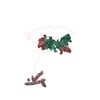+Search query
-Structure paper
| Title | Prion Protein-Antibody Complexes Characterized by Chromatography-Coupled Small-Angle X-Ray Scattering. |
|---|---|
| Journal, issue, pages | Biophys J, Vol. 109, Issue 4, Page 793-805, Year 2015 |
| Publish date | Aug 18, 2015 |
 Authors Authors | Lester Carter / Seung Joong Kim / Dina Schneidman-Duhovny / Jan Stöhr / Guillaume Poncet-Montange / Thomas M Weiss / Hiro Tsuruta / Stanley B Prusiner / Andrej Sali /  |
| PubMed Abstract | Aberrant self-assembly, induced by structural misfolding of the prion proteins, leads to a number of neurodegenerative disorders. In particular, misfolding of the mostly α-helical cellular prion ...Aberrant self-assembly, induced by structural misfolding of the prion proteins, leads to a number of neurodegenerative disorders. In particular, misfolding of the mostly α-helical cellular prion protein (PrP(C)) into a β-sheet-rich disease-causing isoform (PrP(Sc)) is the key molecular event in the formation of PrP(Sc) aggregates. The molecular mechanisms underlying the PrP(C)-to-PrP(Sc) conversion and subsequent aggregation remain to be elucidated. However, in persistently prion-infected cell-culture models, it was shown that treatment with monoclonal antibodies against defined regions of the prion protein (PrP) led to the clearing of PrP(Sc) in cultured cells. To gain more insight into this process, we characterized PrP-antibody complexes in solution using a fast protein liquid chromatography coupled with small-angle x-ray scattering (FPLC-SAXS) procedure. High-quality SAXS data were collected for full-length recombinant mouse PrP [denoted recPrP(23-230)] and N-terminally truncated recPrP(89-230), as well as their complexes with each of two Fab fragments (HuM-P and HuM-R1), which recognize N- and C-terminal epitopes of PrP, respectively. In-line measurements by fast protein liquid chromatography coupled with SAXS minimized data artifacts caused by a non-monodispersed sample, allowing structural analysis of PrP alone and in complex with Fab antibodies. The resulting structural models suggest two mechanisms for how these Fabs may prevent the conversion of PrP(C) into PrP(Sc). |
 External links External links |  Biophys J / Biophys J /  PubMed:26287631 / PubMed:26287631 /  PubMed Central PubMed Central |
| Methods | SAS (X-ray synchrotron) |
| Structure data |  SASDCJ2: |
| Source |
|
 Movie
Movie Controller
Controller Structure viewers
Structure viewers About Yorodumi Papers
About Yorodumi Papers




 Homo sapiens (human)
Homo sapiens (human)